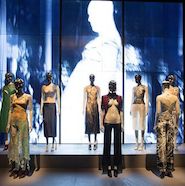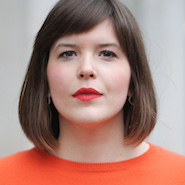- About
- Subscribe Now
- New York,
January 28, 2016

 Alexander McQueen: Savage Beauty exhibition in partnership with Swarovski at the Victoria and Albert Museum, London, March 14 to Aug. 2, 2015. Image copyright V&A Museum
Alexander McQueen: Savage Beauty exhibition in partnership with Swarovski at the Victoria and Albert Museum, London, March 14 to Aug. 2, 2015. Image copyright V&A Museum
The biggest fashion event of 2015? Despite a year that saw H&M’s collaboration with Balmain and London Fashion Week moving to the Brewer Street car park, there is only one answer. Savage Beauty, the Alexander McQueen retrospective at the Victoria and Albert Museum.
How can you compete with the most popular show in the V&A’s history? Almost a half-million tickets were sold, dwarfing previous V&A blockbusters such as Wedding Dresses and Bowie. The show was so popular the museum had to open overnight on the last two weekends to deal with the demand.
And what a show.
If you, like me, were lucky enough to see it you were no doubt entranced by McQueen’s fantastical creations staged in such arresting settings. I found The Cabinet of Curiosities particularly mesmerizing.
But Savage Beauty was not the only fashion exhibition this year – they are becoming quite the trend for major luxury brands.
Show and sell
Take the recent Mademoiselle Prive, which took over all three floors of the Saatchi Gallery, described as “a journey through the origin of Chanel creations, capturing the charismatic personality and irreverent spirit of Mademoiselle Chanel and Karl Lagerfeld.”
Or Louis Vuitton Series 3, where a traditional gallery space was eschewed in favor of a brutalist office block in the Strand for an exhibition that led visitors through the imaginings of creative director Nicolas Ghesquiere and demonstrations of the craftsmanship which underpins Louis Vuitton.
Or even Hermès Wanderland, staged at the Saatchi earlier last year, a tour through the eclectic and eccentric history of Hermès from founder Emile Hermes to the current artistic director Pierre-Alexis Dumas.
And these exhibitions are no toe in the water for these brands – they represent significant financial investments.
 Joanna Carroll is client director at Cream UK
Joanna Carroll is client director at Cream UK
It is not cheap to create a reimagining of a Chanel N° 5 scent-making chamber, complete with supersize vats springing open to spew clouds of dry ice. Nor to fill 13 rooms of a London office block with a variety of wall-to-wall digital screens, banks of lasers and 3D mannequins as Louis Vuitton did, especially when your investment spans a matter of weeks rather than months.
So why are they doing it?
Staging
As McQueen was very aware, fashion is theatre and the stage has traditionally been the catwalk. But with our always-on digital culture, those moments when luxury fashion brands are able to steal the limelight are becoming ever more fleeting.
With live-streaming of fashion shows the norm, the buzz that a brand can create is little more than the 12 minutes of its duration, and then we are all onto the next event.
 Exhibit at Alexander McQueen: Savage Beauty exhibition in partnership with Swarovski at the Victoria and Albert Museum, London, March 14 to Aug. 2, 2015. Image copyright V&A Museum
Exhibit at Alexander McQueen: Savage Beauty exhibition in partnership with Swarovski at the Victoria and Albert Museum, London, March 14 to Aug. 2, 2015. Image copyright V&A Museum
Exhibitions give brands an opportunity to extend that attention. A four-week run for an exhibition like this may not sound like long but compared to a 12-minute catwalk show, it is a lifetime. And the money invested seems wise when you compare the dollars-per-second of a catwalk show versus a month-long exhibition.
There is also the opportunity that a physical environment gives to immerse an audience in the brand’s provenance, values and creative vision.
An hour spent in an exhibition gives a luxury brand an opportunity to forge a real connection with its audience.
For example, it is difficult in a catwalk show to make an audience understand the craftsmanship behind a luxury brand – something that Louis Vuitton showcased by populating its show with its artisans making bags so that visitors could see the different processes, while Chanel demonstrated by hosting embroidery and olfactory workshops.
We also must not forget that luxury stores can be intimidating places, especially for new recruits to the luxury-buying ranks. These exhibitions give potential consumers the ability to engage with the brand on neutral territory, and thus help to smooth the path to potential purchase – whether it be in-store or online.
For these reasons, I do not see these exhibitions as a flash in the pan.
Inevitably, there is more than a smattering of creative director ego to them, but they are more than just vanity projects. I think we will see more of them. Perhaps not for every brand every year – they might lose their capacity to excite – but we will no doubt see more luxury brands trying them.
 Mademoiselle Prive exhibition at the Saatchi Gallery, London, Oct. 15 to Nov. 1, 2015
Mademoiselle Prive exhibition at the Saatchi Gallery, London, Oct. 15 to Nov. 1, 2015
Exhibitions will not work for every brand. Some will try them, fail to generate the same buzz and footfall for their significant outlay, and wish they had not held them.
But for the big luxury brands – those with a fascinating story to tell, a large following of established and aspirant buyers and very deep pockets – there is something significant to be gained.
Exhibitions could be the start of something much bigger – a shift in the marketing emphasis of luxury brands away from paid advertising and catwalk shows to ever more immerse and sensorial solutions.
Lady Gaga and Tom Ford’s video partnership, which in just a few weeks gained more views and comments than almost anything the fashion brand had done in recent years, is a prime example.
The exhibition has proved a successful route to audience engagement among those brands that have dabbled.
Perhaps the real lesson here is that impact at scale can be earned through a broader view of marketing than previously thought.
Joanna Carroll is client director at Cream UK, London. Reach her at joanna@creamuk.com.
Share your thoughts. Click here